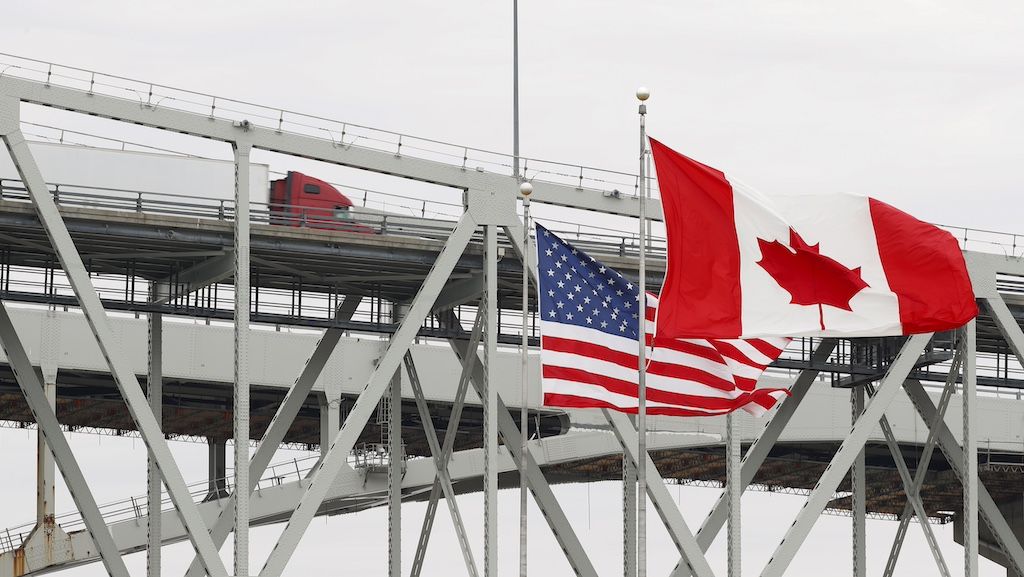

To deal with a reported record number of border crossings, House Republicans recently held a subcommittee hearing — in North Dakota.
That may seem odd, with the federal government and many southern border states locked in a struggle over what to do about migrants illegally crossing into the United States from Mexico. President Joe Biden recently announced plans to curtail asylum migration in response to criticism.
But while the U.S.-Mexico border has received the lion’s share of press coverage, some strange goings-on are afoot along the 5,525-mile U.S.-Canada border as well.
Along certain sections of the border, illegal crossings are reaching unprecedented numbers. In the border region that abuts upstate New York and parts of New England, for instance, agents characterized recent activity as a “flood” of illegal crossers.
In fiscal 2023, Border Patrol agents in that sector nabbed about 7,000 illegal crossers, which was easily more than had been rounded up there in the last 10 years combined. In Boston station WBZ TV’s tour of that section of the border, reporters saw part of that flood when they witnessed Border Patrol agents “arrest a Lithuanian national who tried to cross through the woods abutting a pond that straddles the border between Vermont and Canada.”
The nationalities of those crossers are all over the map, with a very large number at the northern border being from Mexico. One logical explanation for that is that the U.S. is between Canada and Mexico. Mexican citizens who find themselves in Canada either have to travel through the U.S. to get home or skirt the U.S. by boat. Republicans reckon that Mexican drug cartels are one big reason for this influx in illegal northern border traffic.
“You can’t be further away from the Canadian border than Grand Forks,” Rep. Kelly Armstrong (R-ND) said at the May 29 field hearing in that North Dakota city of nearly 59,000 people.
“We’re 70 miles from the Canadian border, but in every single community across the state of North Dakota, somebody is dying from fentanyl poisoning,” said Armstrong, the state’s Republican gubernatorial nominee this fall, and with the Peace Garden State’s strong GOP edge, almost certainly its next chief executive.
Armstrong, first elected to North Dakota’s lone House seat in 2018, added that “100% of those fentanyl pills are made by the cartels in Mexico.”
The federal government doesn’t agree with that percentage or the country of origin for some of the fentanyl production that its agents are fighting. Last year, for instance, “On April 11, 2023, the trial of Marie Um commenced, in Fargo, North Dakota,” the U.S. Department of Justice announced in a news release celebrating victory in that trial.
Um, 42, extradited from Montreal, Quebec, “was part of an organization that was receiving fentanyl and fentanyl analogs from China and importing them into the United States,” according to the DOJ. She was convicted and sentenced to 23 years in prison. Her case was part of “Operation Denial,” which has led to at least 31 defendants being charged in North Dakota and three in Oregon.
While there is some disagreement about how these frequently lethal drugs are getting into North Dakota, and who is carrying them, there is near unanimity about the threat they represent.
“I don’t particularly care how they’re getting here,” Armstrong said. “I want it to stop.”
Four witnesses spoke at the field hearing of the House Judiciary Subcommittee on Immigration Integrity, Security, and Enforcement: the North Dakota attorney general, two sheriffs, and the executive director of the Wahalla Area Chamber of Commerce.
Matters discussed ranged from illegal entry into the U.S. to drug enforcement to the particularly North Dakotan beef over reduced operating hours at U.S. border crossings. Those hours were shortened during COVID-19 lockdowns, which made some sense at the time given the thorough Canadian lockdown and generally closed borders. The Canadian side has returned to regular hours, but many U.S. entries have not.
This mismatch “causes considerable confusion for travelers and disrupts the daily lives and economic activities of our communities,” Chamber of Commerce head Rebecca Davis complained.
Only Republicans on the border?
This is not the first time House Republicans in this Congress have highlighted problems associated with the northern border. The House Northern Border Security Caucus was founded in February 2023 to highlight problems of drug proliferation, smuggling, and national security. House Democrats were invited to join the caucus but declined.
That was the case with the Grand Forks hearing as well, subcommittee Chairman Tom McClintock (R-CA) noted in his opening remarks.
“This is an official hearing of the House of Representatives, and I do want to lament the absence of any Democratic members or even Democratic witnesses or staff at today’s proceedings,” McClintock said.
Still, the hearing’s title was “The Biden Border Crisis: North Dakota Perspectives,” which was not the most inviting for House Democrats.
Frederick Gagnon, a professor at the University of Quebec in Montreal, thinks some matters raised by Republicans are legitimate but can quickly morph into campaign fodder.
“There are certainly issues that require elected officials in both countries to pay more attention to the border at this time,” Gagnon told the Washington Examiner after the formation of the Northern Border Security Caucus.
“In a context where the majority of Americans believe that Biden is not doing the right thing on the border with Mexico, Republicans can give their message even more weight if they convince the public that Biden does not know what he is doing on the border with Canada either,” he added.
Canadian firearm fears
Concerns about the U.S.-Canada border cut both ways, Gagnon pointed out. U.S. politicians tend to focus on drug smuggling from Canada, and Canadian politicians tend to focus on guns smuggled from the U.S. That is true of the Liberal Party, led by Prime Minister Justin Trudeau, and the Conservative Party opposition as well.
Pierre Paul-Hus is the Conservative public safety critic. He said his party wanted to “see a plan that includes support for police anti-gang and gun units, a CBSA Firearms Smuggling Task Force, and increased access to mental health and addictions treatments,” as an alternative to the government’s push for more domestic gun control in 2020, CBC News reported.
CLICK HERE TO READ MORE FROM THE WASHINGTON EXAMINER
Canadian border guards seized 548 firearms in 2020. That number has climbed, but not by much with increased, post-pandemic border traffic factored in.
In 2023, border agents seized 874 firearms coming into Canada, according to the Canada Border Services Agency. In that same year, an estimated 14 million firearms were purchased in the U.S.






